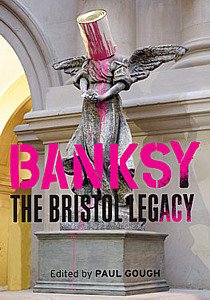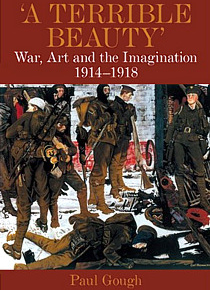
 |
|
Visit the 'Places of Peace' website
Publications
| 'DEAD GROUND' WAR AND PEACE: REMEMBRANCE AND RECOVERY A CULTURAL READING OF MEMORYSCAPES FROM THE GREAT WAR, 1914–1918 Paul Gough In military parlance, ‘dead ground' is terrain that is hidden from view due to undulations or obstacles. In this volume of essays about the abiding memory of the First World War, it refers to a benighted landscape crammed with danger, a haunted place which gripped the imagination. To many artists, poets, writers and musicians it was a phantasmagoric land, a place of wicked enchantment. In this book Paul Gough revisits the battle torn terrain of Belgium, France, Macedonia and Turkey to explore places of traumatic memory that are now peppered with memorials and plaques, connected by countless military cemeteries, those ‘Silent Cities' strung out along the edges of the old battle lines like the beads on a rosary. Published by Sansom and Company in collaboration with The National Trust and the Stanley Spencer Gallery. 220 pages / 260 x 210mm , full colour illustrations, Softback ISBN : 978-1-911408-45-1 FREE Chapter download http://sansomandcompany.co.uk/product/dead-ground-war-and-peace-remembrance-and-recovery/ https://www.amazon.co.uk/Dead-Ground-Peace-Remembrance-Recovery/dp/1911408453/ref=sr_1_2?s=books&ie=UTF8&qid=1545237881&sr=1-2&keywords=paul+gough+Dead+Ground |
||
| 'The Holy Box' Paul Gough Sir Stanley Spencer RA CBE worked at the Beaufort Military Hospital as a medical orderly during the First World War. He later served on the forgotten Macedonian Front with a field ambulance unit and an infantry regiment. He saw action, was traumatized and suffered acute bouts of malaria. Five years after the Armistice he started making numerous drawings recalling in great detail his war service. So impressed were two generous patrons, the Behrends, that they built a small chapel near Newbury to house a cycle of paintings. For five years Spencer toiled in the chapel. The resulting murals are quite extraordinary; they stand comparison with the great painted chapels of early Renaissance Italy. The Sandham Memorial Chapel ranks alongside the poetry of Wilfred Owen and Siegfried Sassoon, and Britten’s War Requiem, as one of the most moving monuments to 20th-century war. This new book draws extensively on rarely seen archive material to relate the origins of the Chapel. It tells the complicated and often intense relationship between the architect, the patron and the painter. The book offers a rich insight into one of the greatest war memorials in northern Europe and is told by leading academics and curators Amanda Bradley, Paul Gough, James Rothwell, Sarah Rutherford. The book has an introduction by Carolyn Leder. Published by Sansom and Company in collaboration with The National Trust and the Stanley Spencer Gallery. 212 pages, over 100 illustrations, 25 in full colour. ISBN 978-1-911408-09-3. http://sansomandcompany.co.uk/shopping/the-holy-box/ https://www.amazon.co.uk/Holy-Box-Paul-Gough/dp/1911408097 |
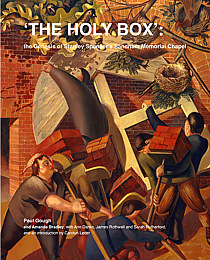 |
|
| Auctioning Stanley Spencer: Oil Painting
Sales 1990-2015 Paul Gough, ‘The elsewhere of my mind…’: reflections on the art of Stanley Spencer, Introduction to Sophie Hatchwell, Paul Gough, Simon Shaw-Miller, Auctioning Stanley Spencer: Oil Painting Sales 1990-2015 Published by Piano Nobile, London, 2016 ISBN10 1901192415 ISBN-13: 978-1901192414 Abstract: The Nobile Index is a series of monographic publications of art sales prices achieved at auction, for a selection of leading 20th-century British artists. Stanley Spencer, arguably one of the greatest British artists of the twentieth-century, is also renowned for his chequered sales history and money struggles. This rigorous study into the prices his work now commands at auctions demonstrates the significance of major sales over the past twenty-five years and the increasing value the market places upon Spencer's paintings. The publication comes in two sections - an introduction by renowned Spencer specialist Professor Paul Gough, results and analysis, and a booklet insert of appendices. View introduction >> Auctioning Stanley Spencer: Oil Painting Sales 1990-2015 |
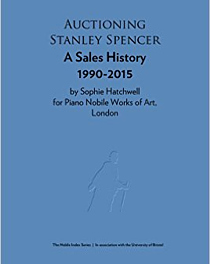 |
|
| ZAWN Walking Penwith | Cliff-edge Painting by Paul Lewin Paul Gough In 1989, at the age of 22, Paul Lewin left Bristol, where he had studied Fine Art for three years and travelled three hours south to West Penwith in Cornwall. He intended to stay for a few months so that he might rekindle an interest in the Cornish landscape he had first experienced at art school. He never returned north and has been based in the far south-west ever since. Lewin hailed from Manchester, that vast conurbation and 'ideopolis' in the north-west of England, arguably the country's second city after London. As a young boy of seven or eight, he remembers being taken for a visit to nearby Stockport College of Art by his father, who was then studying textile design and helping to mix the coloured gouache paint for intricate wallpaper and carpet designs. A talented child at secondary school, the young Lewin showed such potential in drawing that he gained a place at the same college, which was then renowned (as it still is) for its attention to the essentials of fine art practice. Lewin prospered under vthe guidance of such lecturers as Duncan Watnough and Derek Wilkinson who laid taught drawing from rigorous observation and laid down the principles of the craft of painting. This new book takes the form of a collection of existing paintings, and others created specifically for this publication, each painting marking a walking line west from Newlyn along the headland to Land’s End, then north to Zennor. The images are accompanied by a text written by Paul Gough. contextualising Paul Lewin’s practice in the history of Cornish painting, the tradition of en plein work, but also offers a commentary on the artist’s sojourn across West Penwith. The book also includes an interview between the painter and writer which covers the artist’s approach to painting, his methods, materials and those artists and writers who matter most to him. Published in conjunction with an exhibition at Cornwall Contemporary Gallery, Penzance: 9 November – 3 December 2016 Publisher: Sansom and Company ISBN-10: 1908326972 ISBN-13: 978-1908326973 
|
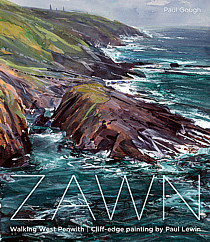 |
|
| 'Back from the Front': Art, Memory
and the Aftermath of War Edited by Paul Gough In the year which marked the centenary of the start of the First World War, a series of creative projects in Bristol considered past, contemporary and continuing conflicts. A unique record of these exhibitions and events has now been captured for this book. Under the generic title Back From the Front: Art, Memory and the Aftermath of War the projects consisted of five overlapping exhibitions staged at the Royal West of England Academy in Bristol, UK - a curated show of work by John and Paul Nash; a unique gathering of work by contemporary artists examining war and peace under the title Shock and Awe: Contemporary Artists at War and Peace, and a sequence of exhibitions united under the word Re-membering, which were a series of commissions funded by the Arts Council England and co-ordinated by the Bristol Cultural Development Partnership and Bristol 2014. A fifth exhibition The Death of Nature gave a showcase to the recent paintings of Michael Porter RWA. 'Back from the Front': Art, Memory and the Aftermath of War Publisher: Bristol Cultural Development Partnership UK Editor: Paul Gough, ISBN: 9780955074257 http://issuu.com/bristolculturaldevelopmentpartnersh/docs/back_to_the_front https://itunes.apple.com/us/book/back-from-the-front/id980887643?ls=1&mt=11 |
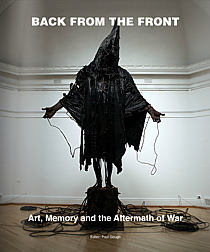 |
|
| Brothers
in Arms: John and Paul Nash Paul Gough with an essay by Gemma Brace (publication July 24, 2014) When brothers John and Paul Nash held their first exhibition in 1913 at the Dorien Leigh Gallery in South Kensington, London they were regarded as equally talented and equally ambitious, even though it had been Paul who had studied at the Slade School of Art amongst an extraordinary cohort of young British artists, and John was regarded as an untutored youngster with a flair for capturing the essence of the English landscape. As war broke their fortunes diverted: Paul achieved instant recognition as an Official War Artist, while John withstood the terrors of the trenches as an infantryman. In 1918 they came together again, painting side by side in an old herb barn to conjure up their searing visions of the Western Front. Once these were finished and exhibited to wide acclaim, they went their different ways. This book explores the work of the two brothers; their family roots in London and Buckinghamshire; the difficult and dark days of their schooling; their divergent early careers and time in the trenches; the moments when they came together to share a show or studio, and also the long periods where their fortune fared so differently, Paul to achieve international recognition as a Modern artist as well as a profoundly English one, while John went quietly about his southern haunts painting the countryside, studying plants and diligently engraving dozens of illustrations. |
||
| Developing themes first explored
in his book about British war artists, A Terrible Beauty, Paul Gough
relates the fascinating story of the Nash brothers, illustrators,
soldiers, and artists. Published to accompany an exhibition at the Royal West of England Academy, Bristol Brothers in Arms: John and Paul Nash 128 pages with 100 illustrations, Sansom & Company, (2014) 230 x 210mm mainly colour Softback ISBN-10: 1908326522 / ISBN-10: 1908326522 |
||
| Banksy : The Bristol
Legacy Banksy - The Verdict In the summer of 2009 Bristol saw a remarkable phenomenon that made international news. An estimated 300,000 people queued for hours, often in pouring rain, for admission to the city’s museum & art gallery. They had been attracted by the media hype surrounding an exhibition ambiguously entitled ‘Banksy vs the Bristol Museum’. There have been many celebratory books about Banksy, but this is the first non-partisan documentation of the Bristol event and an attempt to assess its local and wider impact. More than a dozen commentators, including art curators, historians, economists, journalists and local government managers, attempt to answer a raft of questions: Is Banksy a subversive influence or merely a bit of fun? Why is Banksy so important to Bristol? Are we dealing with art, ‘street art’ or graffiti? Where does the exhibition leave Bristol as an epicentre of ‘street art’? What was its economic impact? The book looks at the setting up of the show and questions the need - other than to conform to the required Banksy mystique - for secrecy. Bristol City Council took an unprecedented risk in allowing the Banksy team a free run of its galleries. The implications of this for future museum practice and for State encouragement of the popular arts are dealt with in detail. In the wake of the exhibition the council designated a run-down area of the inner city for a ‘street art’ bonanza, inviting artists from around the world. The book attempts to judge the success of that initiative. Finally, a practising lawyer asks whether Banksy’s work can be given ‘listed building’ consent. Article: Banksy: Paul Gough : Painter, Polemicist, or Prankster? |
||
| Banksy : The Bristol Legacy 160 pages with 100 illustrations, Redcliffe Press Ltd, (2012) 245 x 170 mm mainly colour Softback ISBN 978-1-906593-96-4 |
||
| A Terrible
Beauty: British Artists in the First World War As war broke out across Europe in 1914 the Vorticist painter Wyndham Lewis advised: ‘You must not miss a war, if one is going! You cannot afford to miss that experience’. He may have been playfully ironic, but he recognised that the Great War presented a set of complex challenges, that might make or break reputations at a critical juncture in British art. Many artists, poets and writers have had to live with the uncomfortable recognition that conflict fuels their muse, invigorating the imagination and honing their creativity. This book explores a diverse group of those artists and their work, from the conservative draughtsmanship of Scottish etcher Muirhead Bone to the irreverent angularity of the young gunner William Roberts; from the publicity-soaked antics of Richard Nevinson to the deluded ambitions of Sir William Orpen. In it, Paul Gough examines the work of those who were made famous by the war, and those whose reputations were almost irretrievably damaged. He explores in detail the wartime lives of fifteen artists - many of whom saw active service - who are central to the way we now visualize the War on the Western Front and on more distant battlefields in Macedonia and Gallipoli. A Terrible Beauty: British Artists in the First World War 256 pages, 120 illustrations Sansom & Company, (2010) 172 x 245 cm mainly colour Softback ISBN-10: 1906593000 / ISBN-13: 978-1906593001 |
| Your Loving
Friend, Stanley: The Great War Correspondence
Between Stanley Spencer and Desmond Chute When serving as an orderly at the Beaufort Military Hospital, Bristol, during the First World War, the young Stanley Spencer met Desmond Chute, a 20-year old aesthete and scion of a noted Bristol theatre family. A close friendship ensued, as the 31 letters in this collection attest. Far more sophisticated and better educated, Chute introduced the older man (Spencer was 24 when they met) to classical literature and great music and, perhaps most crucially, to the Confessions of St Augustine. Chute's influence on Spencer s intellectual development cannot be exaggerated. Spencer's often illustrated letters include some written while awaiting posting overseas, others from the battlefields of Macedonia give glimpses of his tribulations in a theatre of war, along with extraordinarily well-wrought reminiscences of Cookham, colourfully populated with places and characters. A few, concluding, letters were written from Fernlea back in his home village, and Hampstead in the 1920s. Desmond Chute (1895-1962) was for a while at the Slade School of Art. He became an assistant to Eric Gill, and involved in the Guild of St Joseph and St Dominic. He was admitted as a Catholic priest in 1927, moving to Italy where he was a friend of Ezra Pound. He had some success as a published writer and playwright, including a radio play broadcast by the BBC in 1955. All the letters are transcribed for the modern reader; some are also reproduced facsimile with Spencer s illustrations. A series of introductory essays, Stanley Spencer at war and peace, by Paul Gough give the background to the correspondence, discuss its importance to Spencer, and provide previously unpublished information about the Chute family. Archive photographs provide a visual context Your Loving Friend, Stanley: The Great War Correspondence Between Stanley Spencer and Desmond Chute Edited and with essays by Paul Gough 144 pages, Sansom & Company, (2011) 152 x 230 cm ISBN-10: 1906593760 / ISBN-13: 978-1906593766 |
Stanley Spencer : Journey to Burghclere
Paul Gough tells the story of Stanley Spencer's journey from cosseted family life in Cookham, through the menial drudgery of a war hospital and the malarial battlefields of a forgotten front, to his unique visions of peace and ressurection in Burghclere.
Using his own letters, illustrations and paintings the book locates Spencer's work alongside other soldier-artists of the time and shows how his war experiences of 'innocence, fall and redemption' derived from his personal story as 'orderly, soldier and patient'.
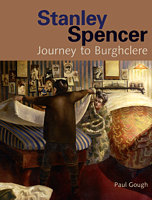
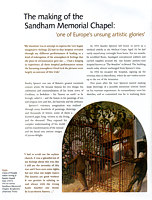
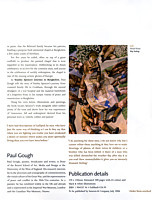
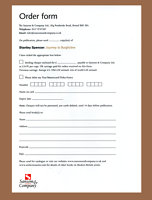
Stanley Spencer : Journey to Burghclere
208 pages with 65 colour and b&w illustrations, Sansom & Company (2006)
ISBN-10: 1904537464 / ISBN-13: 978-1904537465
Chapters in Books
Gough, P.J., (2017) ‘Congested Terrain: Contested Memories. Visualising the Multiple Spaces of War and Remembrance’, in James Wallis and David Harvey, (eds.) Commemorative Spaces of the First World War: Historical Geographies at the Centenary, Ashgate, ISBN: 9781138121188
View text>>
Gough, P.J., (2017) ‘A concentrated utterance of total war’ - Paul Nash, CWR Nevinson and the challenge of representation in the Great War, in Joanna Bourke (ed.) War and Art: A Visual History of Modern Conflict, Reaktion Books, November 2017, pp. 270-282. ISBN-10: 1780238460
View text>>
Gough, P.J., (2016) ‘The elsewhere of my mind…’: reflections on the art of Stanley Spencer, Introduction to Sophie Hatchwell, Paul Gough, Simon Shaw-Miller, Auctioning Stanley Spencer: Oil Painting Sales 1990-2015, Piano Nobile, London, 2016, ISBN10 1901192415.
View text>>
Gough, P.J., (2016) ‘Seeking the kingdom of heaven…’ Stanley Spencer (1891-1959) painter, writer, visionary, in Richard Heathcote and Anna Jug (eds.), Stanley Spencer: A Twentieth-Century Master (Wakefield Press, Adelaide, Australia, 2016).
View text>>
Gough, P.J., (2016) ‘Filling the Void’: artistic interpretations of the empty battlefield, in Raelene Frances and Bruce Scates (eds.), Beyond Gallipoli: New Perspectives on ANZAC (Australian History Publication, Monash University Publishing, 2016) ISBN 978-1-925495-10-2
View text>>
Gough, P.J., (2016) 'Bansky: What’s the fuss and why does it matter?’, in Joseph Siracusa (ed.) Humanities, Arts, and Social Sciences: it’s everyone’s business, (Sydney and London, Routledge, 2016).
View text>>
Gough, P.J., (2015) ‘“Turf Wars”: grass, greenery and the spatiality of commemoration. Recurring debates and disputes in the uses of horticultural iconography by the Commonwealth War Graves Commission in northern Europe.’, chapter 5‘Heimat & Belonging: At Home in the Future', editors John Rodwell and Peter Scott, LIT Verlag,
View text>>
Gough, P.J., (2013) ‘Sutherland at War’, catalogue chapter ‘From Darkness into Light: Graham Sutherland: Mining, Metal and Machines’, Penlee House Gallery, Penzance, 14th September - November 2013, Sansom and Company ISBN-10: 1908326387, ISBN-13: 978-1908326386
View full text>>
Gough, P.J., (2011) ‘The ‘versus’ habit: Bristol, Banksy and the Barons’, in ‘Lest We Forget’, Black Dog Press, eds. Maggie Andrews, Charlie Bagot-Jewitt and Nigel Hunt, The History Press, 2011. ISBN-10: 0752459651, ISBN-13: 978-0752459653
View full text>>
Gough, P.J., (2010) ‘The living, the dead and the imagery of emptiness and re-appearance on the battlefields of the western front'
In: Maddrell, A. and Sidaway, J., eds. (2010) Deathscapes: New Spaces for Death, Dying and Bereavement. Farnham: Ashgate, pp. 263-281. ISBN 9780754679752
View introduction >>
Gough, P.J., (2009) ‘Calculating the future’ – panoramic sketching, reconnaissance drawing and the material trace of war, in Saunders, N and Cornish, P. (eds.) Contested Objects: Material Memories of the Great War, Routledge, pp. 237-251, London, 2009. ISBN 978-0-415-45070-6
View introduction >>
Gough, P.J., (2009) 'Garden of Gratitude’: the National Memorial Arboretum and strategic remembering,'
People and their Pasts: Public History Today, editors Hilda Kean and Paul Ashton, Palgrave, 2009 ISBN 978-0-230-54669-1
View introduction >>
Gough, P.J., (2008) ‘Commemoration of War’, in Graham. B. and Howard, P. (eds.) The Ashgate Research Companion to Heritage and Identity (London: Ashgate) p.323-347, 2008 ISBN-10: 0754649229, ISBN-13: 978-0754649229
View introduction >>
Gough, P.J., (2007) ‘Peace in ruins - the value of mementoes, temporary shrines and floral tributes as markers of public sphere’ in Harutyunyan, A. Horschelmann, K. and Miles, M. (eds.) 'Public Arts after Socialism', Intellect, 2007. ISBN-10: 184150212X, ISBN-13: 978-1841502120
View introduction >>
Gough, P.J., (2001) ‘Through the wrong end of the telescope’ : Military Drawing and British War artists, 1914 – 1918’ in Peindre la Grande Guerre 1914 – 1918, Cahiers d’etudes et de recherches du Musee de’l’Armee Paris 2001, 97 – 111, 4 b & w illus, ISBN 2-901418-260
Gough, P.J., (2001) Landscapes of War (and Peace) in Monuments and the Millennium, James and James / English Heritage, 228 - 236, 4 x b and w illus.
ISBN 1-873936 - 97 – 4
Gough, P.J., (2000) ‘Modernism and Monumentalism: Canada’s part in the development of memorial architecture’ in Canadian Military History since the 17th century (ed. Yves Trembley) pp.507 – 511. Proceedings of the Canadian Military History Conference, Ottawa, 5 – 9 May, 2000, published by Directorate of History and Heritage, Canada ASIN: B001HDTDKM
Gough, P.J., (1999) ‘A War of the Imagination: the experience of British artists in two world wars’ in Lightning Strikes Twice, Personal Experiences of Two World Wars. London, Leo Cooper.
Gough, P.J., (1997) 'An Epic of Mud': Artistic Interpretations of Third Ypres, in Passchendaele in Perspective: the 3rd Battle of Ypres, editor Peter Liddle, chapter 25, 4 b & w illus, Leo Cooper, 1997 ISBN-10: 0850525888, ISBN-13: 978-0850525885
Gough, P.J., (1996) 'The Experience of British Artists in the Great War', in Facing Armageddon: The Great War Experienced, editors Peter Liddle and Hugh Cecil, Pen and Sword/Leo Cooper, London, ISBN 0 -850525063
Gough, P.J., (1995) 'Tales from the Bushy-Topped Tree': A Brief Survey of Military Sketching Imperial War Museum Review No. 10, November 1995, pp 62 - 73, 7 b & w, 4 colour illus. Imperial War Museum/Leo Cooper, London, ISBN 1 870423 19 4
Gough, P.J., (1993) 'The Empty Battlefield: Painters and the First World War', Imperial War Museum Review, no.8, Imperial War Museum/Leo Cooper, 1993, 4 b&w, 4 colour illus. pp. 38 - 47, ISBN 0-901627-99-2
top

